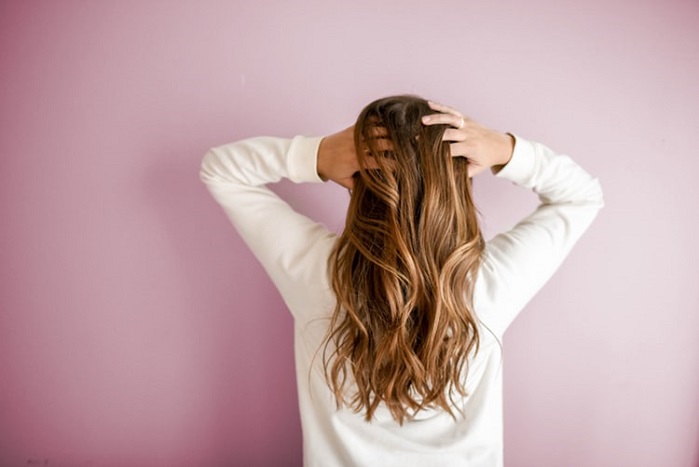
Our hair strands put up with a lot. With all the brushing, combing, styling, washing, and coloring we put it through, it understandably needs a little extra nourishment sometimes.
That’s where leave-in conditioner comes in.
Conditioning provides locked-in moisture that can gift your dry hair with a healthier look and feel. But sometimes, regular conditioners aren’t enough to keep our hair on its A-game.
Leave-in conditioner can provide the same benefits as traditional conditioners with a long-lasting layer of hydrating protection you don’t have to wash out.
Leave In Conditioner 101
Conditioners have been regarded as a hair care staple for decades. But what do conditioners actually do for your hair—and how do leave-in conditioners differ?
Conditioners target two main areas important in maintaining your hair’s health: providing moisture and eliminating static in hair fibers. They do this by employing anti-static and lubricating substances to restore hydration and neutralize static electricity.1
Through this double effort, conditioners can significantly benefit your dry hair by:
- Reducing frizziness
- Retaining moisture
- Restoring damaged cuticles
- Enhancing hair strand smoothness
- Boosting overall shine
It’s safe to say that using hair conditioner in your everyday hair routine can yield some noticeable results.
Regular Conditioner vs. Leave-In Conditioner
Regular conditioner and leave-in conditioner both have their place in healthy hair care. Knowing the difference between them can help shine some light on their specific benefits.
As opposed to regular hair conditioner that you apply in the shower and then wash out, leave-in conditioner stays in your natural hair all day. Designed to feel lightweight and easy on all hair types, a leave-in conditioner can provide your hair with an additional boost of moisture without weighing your natural hair down with a thick, creamy texture.
Suppose your hair is naturally porous or has become more absorbent due to prolonged heat or hair damage.2 In that case, your hair can absorb moisture through leave-in conditioners with ease, providing your hair with a more balanced, nourishing feel.
No matter your hair texture, however, the range of leave-in conditioners out there means you’re bound to find the perfect product for smooth, luxurious locks.
4 Simple Steps to Add Leave-In Conditioner to Your Hair Care Routine
Learning how to use leave-in conditioner is fairly straightforward. To ensure you’re claiming the most moisture-boosting benefits from the process, however, it helps to have some conditioning guidance.
From choosing the right leave-in conditioner to maintaining hair health long-term, the following steps can set you on the path to shiny strands.
#1 Pick the Right Type of Leave-In Conditioner for Your Hair
Your hair’s texture, porosity, and density can all require specific care and attention. In other words, different hair types have different needs. That’s why learning about the specific requirements of your hair can help to ensure your hair gets the best boost possible.
Need some tips for each hair type? Consider the quality of your hair and the most effective way to utilize a leave-in conditioner to take your hair to the next level.3 Different hair types may include:
- Oily hair – Oily hair often doesn’t need as much moisture. Only use a leave-in conditioner occasionally and only apply at the ends of your hair, rather than the roots.
- Frizzy hair – Hair dryness may lead to frizziness. The added moisture from a leave-in conditioner can help hydrate your hair and boost smoothness. A leave-in conditioner can also act as an additional layer of protection against external heat, which can also cause frizziness.
- Curly hair – You can reduce frizziness and add moisture to your curly hair by combing leave-in conditioner through it while it’s still wet. This action will help hydrate your whole head and smooth out your curls, enabling them to dry without frizz.
- Fine hair – Regular conditioners can feel heavy on fine hair. Opt for small amounts of lightweight leave-in conditioner rather than heavy creams. Try to apply conditioner to the ends of your hair to prevent heavy buildup on the crown of your head.
- Damaged hair – Leave-in conditioner can add moisture to damaged and broken hair. It can also act as an additional layer of protection against heat-styling tools such as curling wands or straightening irons. Products like Natura Brasil’s Murumuru Hair Leave-In Conditioner may even help repair weaker hair and give the appearance of shiny ends.
Nourishing your hair type means working with its natural qualities. Now that you’ve identified your hair’s individual type, let’s discuss active hair product ingredients you can look out for to make your hair look and feel the best it possibly can.
#2 Identify Beneficial Ingredients
Giving your hair proper care means you may want to pay attention to the ingredients that go into your nourishing hair treatments.
You may see natural ingredients listed on the side of the conditioner bottle, but knowing the benefits they provide can give you a confident and discerning eye for determining which conditioner will yield the best results for you.
When on the hunt for hydrating leave-in conditioners, these ingredients can manifest some excellent results:4
- Coconut oil – Known to boost protein retention and strengthen hair, coconut oil acts as a healthy companion to any solid leave-in conditioner.
- Avocado oil – An excellent source of vitamin E and B, avocado oil leaves hair feeling smoother and looking shinier thanks to its ability to easily coat the hair with moisture.
- Honeyquat – Derived from natural honey, honeyquat boosts conditioning formulas by quickly absorbing into hair while nourishing antioxidants and providing hydration.
- Glycerin – Glycerin binds water together, which means that having it in your conditioner can help ensure moisture retention.
- Aloe vera – Also known for its skin-soothing properties, aloe vera helps lock in natural moisture in your hair and scalp, leading to improved shine.
- Shea butter – A carrier of vitamin A, E, and natural fatty acids, shea butter uses its fatty acid content to fight against water loss and breakage to help prevent split ends and tangles.
With nourishing ingredients designed to give your hair a needed boost, you can begin the process of conditioning your hair.
#3 Apply Leave-In Conditioner
With this newfound knowledge, we can begin applying the leave-in conditioner. Unlike regular conditioner, leave-in conditioner goes in your hair after your shower routine.
If you’ve ever found yourself wondering how to use leave-in conditioners, it’s probably easier than you think. Firstly, make sure to read the directions on your leave-in-conditioner to ensure you know the approximate amount you should apply to your hair.
From there, you can follow these steps:
- Wash your hair, shampoo, and condition as usual.
- Towel dry your hair upon exiting the shower, gently squeezing out excess water.
- Part your hair in sections if needed.
- Apply leave-in conditioner to your damp hair, starting with the ends and working your way up.
- Brush or comb hair to detangle and spread the conditioner throughout your hair.
- Let your hair air dry, or proceed with your usual styling routine.
The beauty of leave-in conditioner means—guess what?—you get to leave it in. So why don’t you kick back, bake some cookies, or watch some Netflix? Without the worry of rinsing, you can go about your business in peace.
How Often to Apply Leave-In Conditioner
After you’ve discovered how to apply leave in conditioner, you may wonder how often you should repeat this process.
While you should apply regular conditioners after every shampoo, leave-in conditioners offer more flexibility. It would be best to consider how your hair feels and reacts after using the conditioner to determine its usage.
If you notice hair dryness, you may want to use your leave-in conditioner as often as every day. Or, if you notice your hair becoming limp or oily, consider easing up on the conditioner and using it less frequently, like once a week.
#4 Maintain Healthy Hair
Conditioning your hair isn’t just a hobby—it’s a habit. The key to healthy hair may start with nourishing products, but it’s maintained through a routine.
Follow these hair care guidelines to help maintain and improve your hair health with each passing day:5
- Shampoo your scalp – Since shampoo acts as a cleanser, it’s best to keep it on the scalp so it can combat buildup rather than dry out the rest of your hair. Though many previously thought it was best to wash your hair every single day, in recent years, it’s become clear that washing your scalp less frequently can help prevent hair damage, dryness, and an itchy scalp.6 Try IGK Legendary Dream Hair Shampoo & Conditioner for a nourishing, clean feel.
- Condition ends – Since the scalp produces enough oil on its own, you don’t need to add to it by conditioning your roots. You should use conditioner after every shampoo use, but try to direct it on the ends of your hair to target breakage and split ends.
- Avoid heat – Direct heat can cause significant hair damage, making the conditioner’s job harder. To minimize damage, you should take preventative measures against direct heat sources. You can practice this by air-drying your hair, avoiding heat stylers (curling iron, hair straightener, etc.), and using heat protectant whenever you do use heat stylers. Luckily, a leave-in conditioner can sometimes act as a heat protectant.
- Introduce extra moisture – At the end of the day, your hair can almost always use a little extra moisture, especially for the ends. That’s why leave-in conditioners (along with other hydrating products, like oils and serums) can help keep your hair happy and healthy.
Treat your hair right by giving it the support it deserves. With a thorough hair routine, you may find your hair looking sleeker and fuller than ever before.
Promote Healthy Hair with FabFitFun
A leave-in conditioner can give your hair a hydrating helping hand to keep it looking sleeker, shinier, and stronger with every use. With the stress of tangled or frizzy hair slowly melting away, you’ll have more time on your hands to worry about the things that matter most to you (and enjoy that fabulous ‘do).
At FabFitFun, we believe in providing you with tips, tricks, and top-of-the-line products to make the most of your daily routine. Whether you’re focusing on healthy hair, skincare, beauty products, or anything in-between, we’ve got you covered.
Discover the joys of a FabFitFun lifestyle today.
Sources:
- National Library of Medicine. Hair Cosmetics: An Overview. https://www.ncbi.nlm.nih.gov/pmc/articles/PMC4387693/
- Healthline. How to Identify and Style your Hair Type. https://www.healthline.com/health/beauty-skin-care/types-of-hair#porosity-and-density
- Healthline. How to Use Leave in Conditioner. https://www.healthline.com/health/how-to-use-leave-in-conditioner#benefits
- Naturally Curly. 7 Super Hydrating Ingredients for Natural Hair. https://www.naturallycurly.com/curlreading/curls/7-super-hydrating-ingredients-for-natural-hair
- Florida Academy. Top 10 Hair Care Tips for Every Hair Type. https://florida-academy.edu/top-10-hair-care-tips-every-hair-type/
- Cleveland Clinic. Here’s How Often You Should Wash Your Hair. https://health.clevelandclinic.org/the-dirty-truth-about-washing-your-hair/




